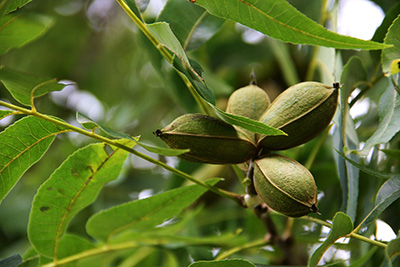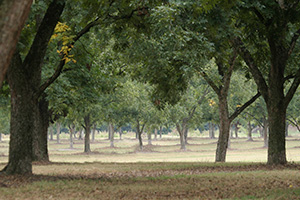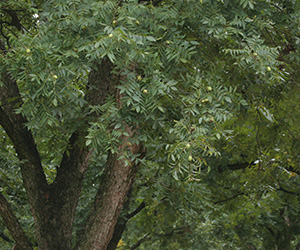Pecan

Pecan trees are a common sight throughout the South, as far west as California and as far north as Illinois. Native Americans used pecans as a food source for thousands of years before the arrival of Europeans. In fact, the word “pecan” is an Algonquin word meaning “all nuts requiring a stone to crack.” Today the U.S. produces most of the world’s pecan crop, with Florida generating five to ten million pounds annually. Although pecan is not a low-maintenance tree, the reward of delicious nuts is enough to convince many gardeners to add it to their landscape.
Characteristics

Carya illinoensis is native to North America and is massive in stature. Mature trees are typically 70 to 100 feet tall and 40 to 75 feet wide, although they can be larger. Trees tend to be uniform and symmetrical in shape with many branches, and as a result make excellent shade trees.
The leaves are odd-pinnately compound, with 9-17 leaflets. Leaflets are three to eight inches long and are lanceolate with serrated edges. Leaves are dark green on top and paler on the bottom until they turn golden in the fall.
In the spring, yellow-green male and female flowers appear. Fruits, green to brown and oval-shaped, mature in early fall and are an inch or two long. The husk splits apart to reveal the nut underneath when mature. Interestingly, the inside of a pecan nut is actually liquid before it solidifies into a tasty morsel. Squirrels and other mammals will happily devour any nuts that you don’t harvest.
Planting and Care
Pecan trees are recommended for planting in zones 5B through 9A in landscapes that are large enough to accommodate their size. Although they can theoretically grow further south, nut production tends to not be as high. There are many available cultivars, but we recommend planting ‘Elliott’, ‘Excel’, ‘Lakota’, and ‘Sumner’. Only select cultivars that are documented as having good resistance to scab.
Choose a planting location in full sun to partial shade with soil that is fertile, well drained, and moist. Note that pecan is not salt tolerant and will require more irrigation if planted in shallow or sandy soils. Don’t plant pecan next to cars or sidewalks since the leaves and husks will stain clothes, pavement, and cars when it rains. Falling nuts can also harm vehicles.
The best time to plant is between late November and February since this is the dormant season. At the nursery, you can select either bare-root or container plants. For bare-root plants, look for trees that are at least six feet tall with roots that are at least two and a half feet long. If the roots feel dry, soak them in water for a few hours before planting.

When you’re ready to plant, dig a hole that is about two feet in diameter and two and a half feet deep. You’ll want the tree to be planted at the same depth that it was at the nursery. Make sure to remove any broken roots and organic matter that could decay from the planting hole. For bare-rooted plants, vertically extend the taproot into the hole. For container plants, the taproot may be circling the pot. You can either cut it to make it straight or pull it downwards when you plant the tree.
Once your tree is in the ground, backfill the hole and tamp the soil. Thoroughly irrigate it with at least 10 gallons of water. Next, you should remove between a half and a third of the canopy. This is called “tree training” and will help balance the production of roots and shoots. The goal is to train the tree to have a central leader. Lateral branches should be spaced about 18 inches apart vertically and create a symmetrical canopy. Branches that are properly spaced are less likely to drop from the tree than those that are too close. Any sprouts that pop up from the rootstock should be removed. Avoid unnecessary pruning for the first several years to encourage growth.
Pecan trees are wind pollinated and have monoecious (male or female) flowers. Male and female flowers do not appear at the same time for each cultivar, meaning the best way to ensure high yields is to plant two or more cultivars together for cross-pollination. The University of Georgia created a helpful chart that shows which cultivars are compatible (PDF).
Although mature trees rarely require supplemental irrigation, it is important to keep your tree hydrated during the establishment period. Ideally, trees will receive 10 gallons of water per day for the first two years. After that, supplemental irrigation is optional for increased yields.
It’s a good idea to complete a soil test before making a fertilization plan. Review the soil test results with your local Extension agent to learn which type of fertilizer to use and when to apply it. When applying, spread the fertilizer in a circle that is three to five feet in diameter around the base of the tree. Make sure to keep fertilizer off the trunk. Weeding around the tree will help ensure that all of your irrigation and fertilizer goes to the tree.

As mentioned before, pecan is not a low-maintenance shade tree. Proper pruning is necessary to help prevent disease from occurring and limbs from falling (as they are prone to do). There are a number of diseases that can occur, but the most common is scab. Only plant cultivars that are scab resistant. Other diseases that you may encounter include hickory anthracnose or leaf spot, fungi-caused leaf spot, powdery mildew, cankers, and verticillium wilt.
Potential pests to look out for include aphids, hickory leaf-stem gall phylloxera, hickory bark beetles, twig-girdler larva, June beetles, caterpillars, scales, spittlebugs, and pecan weevils. Squirrels stealing nuts can also be a problem, especially if you have many hardwood trees in your yard. If you spot signs of pest or disease damage, contact your county Extension office for advice.
The number of pecans you’ll harvest and when they’ll start appearing depend on your cultivar. Once your tree is several years old, start looking for mature pecans in the fall!
